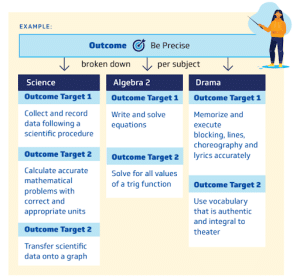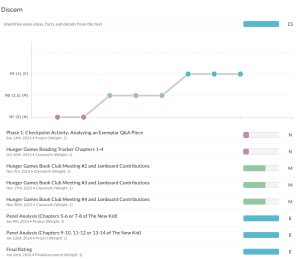There’s A Google Doc For That! One School’s Journey Creating a Comprehensive “Mastery Handbook”
CompetencyWorks Blog
The power of the Google Doc to guide our journey became somewhat of a running joke at our weekly mastery (a term we use interchangeably with competency-based education (CBE)) team meetings. In addressing an area of growth or an instructional problem of practice, someone would proclaim, “We need clearer guidance or a tool to help teachers develop or implement [insert component of CBE].” Then, the group would announce, almost in unison, “I think there’s a Google Doc for that!”
Established in 2006, The Young Women’s Leadership School (TYWLS) of Astoria is a New York City public single-sex school serving grades 6-12 with approximately 80 students in each grade. After our founding principal brought the idea of competency-based grading to a staff meeting in 2008, we never looked back. When the Competency Collaborative launched in 2015, TYWLS became an inaugural Living Lab in the network, but at the time, CBE felt like an underground, grassroots movement of sorts. Aside from a few resources, we were mostly building our system from scratch, making decisions based on the mantra: students first.

Those early meetings were long, exhilarating, and, at times, headache-inducing. For example, I have a vague memory of a several hour-long debate about the nuanced differences between the terms “proficient” and “meeting standards.” At another cross-disciplinary meeting, we pushed and pulled about the differences between “create” and “innovate” – a debate that continues today. While these early decisions helped lay the groundwork for our school’s current and often-lauded approach to CBE, excavating the land and laying the foundation does not make a house or a school in this case. Fully operationalizing our vision for successful CBE required many years of focused implementation, constant iteration, and, yes, thousands of Google Docs.
Although helpful, these disparate documents of guidelines, planning tools, and instructional resources were often difficult to locate and rarely used systematically. Recognizing the need for a more cohesive and accessible resource, our school’s mastery team concluded that consolidating this varied guidance into a comprehensive, multi-purpose mastery handbook would not only spare us from another round of the erratic ‘Google Doc hunting’ experience, but also significantly enhance our capacity for purposeful continuous improvement.
The Inception of the Teacher Mastery Handbook
In 2010, on an ordinary Saturday, six dedicated members of the mastery team gathered in a Midtown Manhattan apartment. The goal: to draft what would become our first Mastery Handbook. As we dreamed of a version for students, staff, and parents/caretakers – complete with translations and videos – the sheer magnitude of creating even the teacher’s edition loomed large.

This first iteration became a living document that mirrored our journey. We ventured into uncharted territories, testing and refining our approach. Some strategies proved transformative, while others required adjustments. We developed practical tools that translated theory into classroom practices. We decided to create truncated versions for parents and students, a practical compromise given the consuming task at hand. Crucially, student and parent/caretaker input about the user-friendliness of the handbook became integral, and this dynamic exchange prompted the realization that our handbook needed a transformation of its own. In 2019, to encapsulate our growth and respond to the evolving needs of our learning community, we embarked on a journey to revamp the handbook. This process involved not only our dedicated educators but also enlisted the expertise of a graphic designer, Svenja Greenwood, to ensure that our evolving vision and practices were visually represented and easily accessible to all stakeholders.

In this inaugural post of a three-part series, we unveil the first chapter of our journey, shedding light on key segments of our revamped and dynamic Teacher Mastery Handbook. Unlike conventional handbooks resigned to gathering dust on classroom shelves, we intended to create a living, breathing guide actively utilized by teachers. Embracing a growth mindset, we acknowledge that we are “not yet” at the pinnacle of seamless handbook utilization. Yet we recognize this phase as a pivotal moment for our continuous improvement. In each post, we will highlight specific sections of our updated Teacher Mastery Handbook, not to suggest completion, but rather to openly share our progress and invite your engagement.
Our Teacher Mastery Handbook begins with an overview of our school’s approach to mastery or competency-based learning, which is the focus of the remainder of this post.
Outcomes and Outcome Targets
The majority of courses at our school are year-long, or annualized. Instead of receiving only one grade for an entire class, each student is given a rating for each skill in that class. These skills are called outcome targets.
Each outcome target is connected to one of our ten school-wide outcomes, often referred to as a shared outcome. In each subject and classroom, our learning is grounded in these ten shared outcomes that identify essential 21st Century skills crucial for success in college and beyond: Argue, Be Precise, Collaborate, Communicate, Conclude, Create, Discern, Innovate, Investigate, and Plan.
We ask that teachers teach and assess between 9-15 outcome targets for a year-long course and between 4-8 for semester-long classes.
 Ratings and Evidence
Ratings and Evidence

A student earns either a Not Yet (NY), Meets Standard (MS), or Exceeds Standard (ES) for each outcome target taught and assessed in a course, based on their ratings for individual pieces of evidence. Evidence can be many things, such as an essay, a long-term project, a test or quiz, or a range of other formative or summative assessments. The idea is that students will have multiple, authentic, and varied opportunities to demonstrate growth within an outcome target by producing a variety of evidence throughout a course. A student achieves “mastery” of an outcome target upon performing that skill at MS or above grade or course level (e.g., ES). When a student achieves “mastery” of an outcome, they continue to develop and transfer this skill in different contexts and/or focus on new outcomes or skills that they have “not yet” mastered.
Transcripts
Since our school is annualized, official transcripts with grades for year-long courses are created at the end of the school year, though semester-long electives and intensives do get grades at the end of the course.
While each outcome target is rated on an NY, MS, ES scale, our school’s online grading platform converts the final ratings into a numeric grade. This feature, however, can and is turned on or off at different times of the year to encourage students, parents, and teachers to speak in the outcome language instead of the traditional number system.

Curriculum Mastery Unveiled
The next and largest section of our Teacher Mastery Handbook, which will be the main focus of my next post, offers comprehensive guidance to teachers in crafting curriculum and designing instructional plans to bolster mastery-based learning in the classroom. This segment incorporates elements of backward design and project-based learning (PBL). It provides an organized framework that serves as both a planning tool and a roadmap for constructing curriculum and learning experiences aligned with mastery-based learning principles.
As we draw this inaugural post to a close, I reflect on the profound concept of a “handbook.” More than a set of instructions, this tool embodies a journey – an unfolding narrative of exploration and growth. We invite you to delve further into our handbook’s pages, discovering the stories, insights, and shared experiences that await in the posts to come.
Learn More
- The Young Women’s Leadership School of Astoria
- Catalyzing Mastery-Based Learning: NYC’s Mastery Collaborative
- CBE Starter Pack 6: Equity Strategies Drive Culture, Structures, and Pedagogy
 Greg Zimdahl is a middle school humanities teacher at TYWLS in Astoria, Queens, where he began teaching 16 years ago after graduating from NYU’s Steinhardt School of Education with a Bachelor of Science in Social Studies Education. In 2011, Greg earned his Master of Arts in African American Studies from the acclaimed Institute for Research in African American Studies at Columbia University. In addition to teaching, Greg currently serves as an Instructional Coach and oversees the school’s Mastery Team, including a Youth Ambassador Program. He collaborated with the founding teacher team to design and implement the school’s nationally acclaimed full school competency-based system. Greg has spearheaded several essential structures and systems at TYWLS of Astoria, such as the new Teacher Residency Program, Intensives (a ten-day, school-wide event engaging students in project-based learning with a culminating public expo), and ACT Advisory Camp TYWLS (a two-day immersive project at the start of the academic year aimed at fostering community and setting norms).
Greg Zimdahl is a middle school humanities teacher at TYWLS in Astoria, Queens, where he began teaching 16 years ago after graduating from NYU’s Steinhardt School of Education with a Bachelor of Science in Social Studies Education. In 2011, Greg earned his Master of Arts in African American Studies from the acclaimed Institute for Research in African American Studies at Columbia University. In addition to teaching, Greg currently serves as an Instructional Coach and oversees the school’s Mastery Team, including a Youth Ambassador Program. He collaborated with the founding teacher team to design and implement the school’s nationally acclaimed full school competency-based system. Greg has spearheaded several essential structures and systems at TYWLS of Astoria, such as the new Teacher Residency Program, Intensives (a ten-day, school-wide event engaging students in project-based learning with a culminating public expo), and ACT Advisory Camp TYWLS (a two-day immersive project at the start of the academic year aimed at fostering community and setting norms).